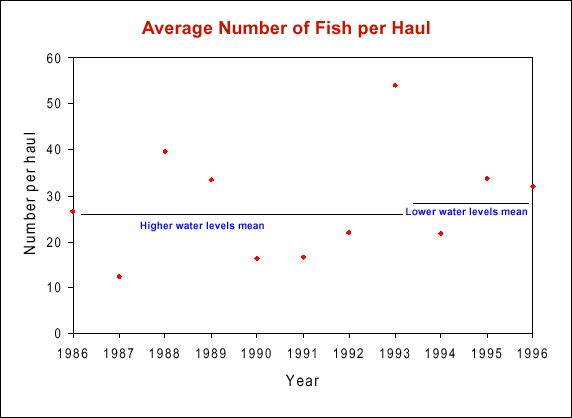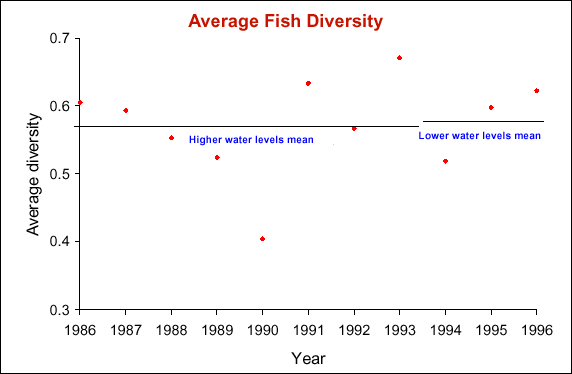|
PSR 99-09 September 1999 Fish Response to Lowered Summer Water Levels in St. Louis District Pools of the Upper Mississippi Riverby Joseph H. Wlosinski and Elmer Atwood |
||
|
An attempt to improve habitat by lowering water levels, while maintaining a nine-foot navi-gation channel, began in 1994 on Pools 24, 25, and the Melvin Price Pool (Pool 26) of the Upper Mississippi River. This experiment, conducted to better simulate the natural hydrograph, was performed at the request of the Pool 25 Natural Resources Management Committee (Committee) who has the goal of improving habitat on the Upper Mississippi River floodplain. The Committee, comprised of members from the Upper Midwest Environmental Sciences Center, US Army Corps of Engineers, U. S. Fish and Wildlife Service, Illinois Department of Natural Resources, and the Missouri Department of Conservation, considered the experiment successful mainly due to increased plant production. Some concern was raised, however, over whether or not lowered water levels may have negatively affected the fish community. To help answer this, we analyzed minnow seining data that was routinely collected by the Illinois Department of Natural Resources between 1986 and 1996 from all three pools. We tested differences between 1986-1993 when pools were held on the high side of the operating band versus 1994-1996 when pools were held on the low side of the operating band during early to mid-summer. Two to four seining trips between May and September were made every year from 1986 to 1996 on four habitat types (i.e., tailwater, main channel border, side channel, and backwater) and four substrates (i.e., concrete, cobble, gravel, and sand). The yearly number of seine hauls in each pool, rang-ing from 8 to 62, was recorded. For analyses, fish collected from all hauls at a site were pooled and all seine hauls were considered comparable with respect to catch rate. We analyzed the minnow seining data using means of the total numbers of fish per haul and Simpson’s Diversity Index (SDI). These values were calculated for every year within each pool. Catch per haul was also calculated for the upriver versus downriver portions of each pool because lowered water levels were more pronounced near the controlling dam. The SDI metric is influenced by the richness and evenness of populations. The value of the index is zero when only one species is present in the sample and approaches one when the sample contains numerous species, each with the same population size. We arbitrarily assigned a SDI of -0.1 for those cases where no individuals were found in a sample. Because the number of species can be a function of the number of hauls, we subsampled eight hauls from all hauls in a pool, for each year, ten different times, calculating a SDI for each time. The ten different SDI’s were than averaged. Fish groups that could not be identified to species (e.g., shiners, buffalo, and species crosses) were treated as a single species. |
||
|
||
|
The total number of fish per haul averaged over all three pools is shown in Figure 1. The average number of fish per haul between 1986 and 1993 was 27.6 in all three pools combined, as compared to an average of 29.2 fish between 1994 and 1996. The total number of fish collected per haul in the upriver portions of the pools averaged 22.6 between 1986 and 1993 and 21 between 1994 and 1996. In the downriver portion of the three pools, the average number of fish per haul between 1986 and 1993 was 32.9, as compared to an average of 40 fish between 1994 and 1996. Similar results were found for Simpson’s Diversity Index (Figure 2). The average index was 0.57 for all three pools when water levels were held on the high side of the operating band, compared with an index of 0.58 between 1994 and 1996 when water levels were held on the lower side of the operating band. Our analyses were performed on all fish species combined. Undoubtedly, analyses on individual species would probably show that results for some species were higher, and others lower, when comparing the two water level management conditions. Although definitive results are not possible because all conditions on the three pools could not be controlled, the two analyses reported here suggest that lower water levels at the three dams in the St. Louis District between 1994 and 1996 had not lowered the numbers of small fish found in near-shore habitats. |
||
|
||
|
This report is a product of the Long Term Resource Monitoring Program for the Upper Mississippi River System. For further information, contact Dr. Joseph H. Wlosinski Elmer Atwood Project Status Reports (PSRs) are preliminary documents whose purpose is to provide information on scientific activities. Because PSRs are only subject to internal peer review, they may not be cited. Use of trade names does not imply U.S. Government endorsement of commercial products. All Project Status Reports are accessible through the Upper Midwest Environmental Sciences Center’s website at http://umesc.usgs.gov/reports_publications/psrs/umesc_psr.html |
Page Last Modified: April 17, 2018



